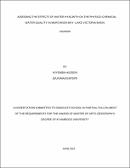| dc.description.abstract | Despite its aggressive nature the water hyacinth, its extent and impact on water quality is not well documented. This study involved mapping the extent and pattern of water hyacinth between 2016 and 2019, determining the effect of water hyacinth on physico-chemical properties of water, and establishing the perceived determinants of water hyacinth extent and distribution pattern in Murchison Bay on Lake Victoria. A cross-sectional study design was adopted for the study following both qualitative and quantitative approaches. Sentinel 2A images of the study area for the period, 2016-2019 were used to map the water hyacinth extent and distribution pattern. 10 pairs of water-sampling point locations were determined for water sampling in areas with water hyacinth and those from open lake at an average distance of 500 meters from each sampling point. Respondents (201) were also sampled (purposively) from the landing sites of Ggaba, Port Bell and Mulungu, comprising of fishermen, traders, fisheries officers, officials from national water, and local residents. The respondents were asked to rate 15 factors on a scale of 1- 4 to show the extent to which they believed determined extent and pattern of distribution of water hyacinth. A Two-way ANOVA was conducted to determine the effect of sampling environment and depth on water quality parameters. The results that in 2016, water hyacinth covered a land area of 511 km2 (1%) which increased to 2,434 km2 (4%) in 2017. The coverage dropped to 1,542 km2 (3%) in 2018. The coverage increased again in 2019 to 2138 km2 (4%). The two-way ANOVA results indicated significant effect of sampling environment on pH, DO, COD, BOD, Turbidity, TP and Transparency but not EC, and temperature. The effect of sampling depth was only significant on pH, EC, BOD and DO while the interactive effect of environment and depth was insignificant for all water quality parameters. From the socio-economic data, sewerage effluent discharge, blowing of local winds and path of Ferry Navigation were perceived as key determinants of water hyacinth distribution. It was concluded that: (i) the extent and distribution of water hyacinth in Murchison Bay varies over space and time but concentration is mainly on the northern shores, (iii) Water hyacinth significantly affects water quality, in some cases beyond the WHO maximum permissible limits for human consumption, and the perception of the determinants of water hyacinth extent and distribution vary across Murchison Bay. Therefore, water resources management departments in the country should put up practical measures to control proliferation of the water hyacinth on water bodies. Future research should focus on long-term monitoring of water quality parameters with reference to water hyacinth infestation. | en_US |

